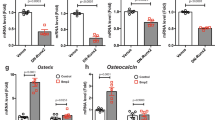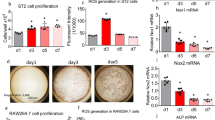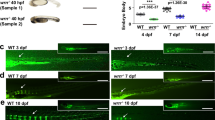Abstract
Runx2 (runt-related transcription factor 2, also known as Cbfa1, Osf2 and AML3) is essential for bone development in mice, and mutations in RUNX2 are found in 65–80% of individuals with cleidocranial dysplasia1,2. Although all Runx family members can interact with Cbfβ (core-binding factor b, encoded by Cbfb), a role for Cbfβ in bone development has not been demonstrated owing to lethality in Cbfb−/− mouse embryos at 12.5 days post coitum (d.p.c.) from hemorrhages and lack of definitive hematopoiesis3,4. Using a 'knock-in' strategy, we generated mouse embryonic stem (ES) cells that express Cbfb fused in-frame to a cDNA encoding green fluorescent protein (GFP)5. Cbfb+/GFP mice had normal life spans and appeared normal, but CbfbGFP/GFP pups died within the first day after birth. The CbfbGFP/GFP mice exhibited a delay in endochondral and intramembranous ossification as well as in chondrocyte differentiation, similar to but less severe than delays observed in Runx2−/− mice6,7. We demonstrate that Cbfβ is expressed in developing bone and forms a functional interaction with Runx2, and that CbfbGFP is a hypomorphic allele. The fusion allele maintains sufficient function in hematopoietic cells to bypass the early embryonic lethality, and identifies a new role for Cbfb in bone development. Our findings raise the possibility that mutations in CBFB may be responsible for some cases of cleidocranial dysplasia that are not linked to mutations in RUNX2.
This is a preview of subscription content, access via your institution
Access options
Subscribe to this journal
Receive 12 print issues and online access
$209.00 per year
only $17.42 per issue
Buy this article
- Purchase on Springer Link
- Instant access to full article PDF
Prices may be subject to local taxes which are calculated during checkout






Similar content being viewed by others
References
Mundlos, S. Cleidocranial dysplasia: clinical and molecular genetics. J. Med. Genet. 36, 177–182 (1999).
Zhou, G. et al. CBFA1 mutation analysis and functional correlation with phenotypic variability in cleidocranial dysplasia. Hum. Mol. Genet. 8, 2311–2316 (1999).
Wang, Q. et al. The CBFβ subunit is essential for CBFα2 (AML1) function in vivo. Cell 87, 697–708 (1996).
Sasaki, K. et al. Absence of fetal liver hematopoiesis in mice deficient in transcriptional coactivator core-binding factor β. Proc. Natl Acad. Sci. USA 93, 12359–12363 (1996).
Kundu, M. et al. Role of Cbfb in hematopoiesis and perturbations resulting from expression of the leukemogenic fusion gene Cbfb–MYH11. Blood 100, 2449–2456 (2002).
Komori, T. et al. Targeted disruption of Cbfa1 results in a complete lack of bone formation owing to maturational arrest of osteoblasts. Cell 89, 755–764 (1997).
Otto, F. et al. Cbfa1, a candidate gene for cleidocranial dysplasia syndrome, is essential for osteoblast differentiation and bone development. Cell 89, 765–771 (1997).
Kagoshima, H., Akamatsu, Y., Ito, Y. & Shigesada, K. Functional dissection of the α and β subunits of transcription factor PEBP2 and the redox susceptibility of its DNA binding activity. J. Biol. Chem. 271, 33074–33082 (1996).
Miller, J.D., Stacy, T., Liu, P.P. & Speck, N.A. Core-binding factor β (CBFβ), but not CBFβ-smooth muscle myosin heavy chain, rescues definitive hematopoiesis in CBFβ-deficient embryonic stem cells. Blood 97, 2248–2256 (2001).
Kim, I.S., Otto, F., Zabel, B. & Mundlos, S. Regulation of chondrocyte differentiation by Cbfa1. Mech. Dev. 80, 159–170 (1999).
Zhang, Y.W. et al. A RUNX2/PEBP2α A/CBFA1 mutation displaying impaired transactivation and Smad interaction in cleidocranial dysplasia. Proc. Natl Acad. Sci. USA 97, 10549–10554 (2000).
Harada, H. et al. Cbfa1 isoforms exert functional differences in osteoblast differentiation. J. Biol. Chem. 274, 6972–6978 (1999).
Otto, F., Kanegane, H. & Mundlos, S. Mutations in the RUNX2 gene in patients with cleidocranial dysplasia. Hum. Mutat. 19, 209–216 (2002).
Tahirov, T.H. et al. Structural analyses of DNA recognition by the AML1/Runx-1 Runt domain and its allosteric control by CBFβ. Cell 104, 755–767 (2001).
Warren, A.J., Bravo, J., Williams, R.L. & Rabbitts, T.H. Structural basis for the heterodimeric interaction between the acute leukaemia-associated transcription factors AML1 and CBFβ. EMBO J. 19, 3004–3015 (2000).
Thirunavukkarasu, K., Mahajan, M., McLarren, K.W., Stifani, S. & Karsenty, G. Two domains unique to osteoblast-specific transcription factor Osf2/Cbfa1 contribute to its transactivation function and its inability to heterodimerize with Cbfβ. Mol. Cell. Biol. 18, 4197–4208 (1998).
Prince, M. et al. Expression and regulation of Runx2/Cbfa1 and osteoblast phenotypic markers during the growth and differentiation of human osteoblasts. J. Cell. Biochem. 80, 424–440 (2001).
Javed, A. et al. Runt homology domain transcription factors (Runx, Cbfa, and AML) mediate repression of the bone sialoprotein promoter: evidence for promoter context-dependent activity of Cbfa proteins. Mol. Cell. Biol. 21, 2891–2905 (2001).
Hanai, J. et al. Interaction and functional cooperation of PEBP2/CBF with Smads. Synergistic induction of the immunoglobulin germline Calpha promoter. J. Biol. Chem. 274, 31577–31582 (1999).
Shirakabe, K., Terasawa, K., Miyama, K., Shibuya, H. & Nishida, E. Regulation of the activity of the transcription factor Runx2 by two homeobox proteins, Msx2 and Dlx5. Genes Cells 6, 851–856 (2001).
Javed, A. et al. Groucho/TLE/R-esp proteins associate with the nuclear matrix and repress RUNX (CBFα/AML/PEBP2α) dependent activation of tissue-specific gene transcription. J. Cell. Sci. 113, 2221–2231 (2000).
D'Alonzo, R.C., Selvamurugan, N., Karsenty, G. & Partridge, N.C. Physical interaction of the activator protein-1 factors c-Fos and c-Jun with Cbfa1 for collagenase-3 promoter activation. J. Biol. Chem. 277, 816–822 (2002).
Gutierrez, S. et al. CCAAT/enhancer-binding proteins (C/EBP) β and Δ activate osteocalcin gene transcription and synergize with Runx2 at the C/EBP element to regulate bone-specific expression. J. Biol. Chem. 277, 1316–1323 (2002).
Speck, N.A. & Gilliland, D.G. Core-binding factors in haematopoiesis and leukaemia. Nature Rev. Cancer 2, 502–513 (2002).
Yoshida, T. et al. Functional analysis of RUNX2 mutations in Japanese patients with cleidocranial dysplasia demonstrates novel genotype–phenotype correlations. Am. J. Hum. Genet. 71, 724–738 (2002).
Miller, J. et al. The core-binding factor β subunit is required for bone formation and hematopoietic maturation. Nature Genet. 32, 645–649 (2002).
Yoshida, C.A. et al. Core-binding factor β interacts with Runx2 and is required for skeletal development. Nature Genet. 32, 633–638 (2002).
St-Jacques, B., Hammerschmidt, M. & McMahon, A.P. Indian hedgehog signaling regulates proliferation and differentiation of chondrocytes and is essential for bone formation. Genes Dev. 13, 2072–2086 (1999).
Ducy, P., Zhang, R., Geoffroy, V., Ridall, A.L. & Karsenty, G. Osf2/Cbfa1: a transcriptional activator of osteoblast differentiation. Cell 89, 747–754 (1997).
Meyers, S., Lenny, N., Sun, W. & Hiebert, S.W. AML-2 is a potential target for transcriptional regulation by the t(8;21) and t(12;21) fusion proteins in acute leukemia. Oncogene 13, 303–312 (1996).
Adya, N., Stacy, T., Speck, N.A. & Liu, P.P. The leukemic protein core-binding factor β (CBFβ)-smooth-muscle myosin heavy chain sequesters CBFα2 into cytoskeletal filaments and aggregates. Mol. Cell. Biol. 18, 7432–7443 (1998).
Banerjee, C. et al. Differential regulation of the two principal Runx2/Cbfa1 N-terminal isoforms in response to bone morphogenetic protein-2 during development of the osteoblast phenotype. Endocrinology 142, 4026–4039 (2001).
Acknowledgements
We thank G. Karsenty for the osteocalcin and p6XOSE2 reporter constructs and for the Runx2 expression plasmid, S.C. Chandrasekharappa for the polyclonal antibody against MEN1, N. Speck for the polyclonal antibody against Runx1 and D. Leja for help in formatting figures. M.K. is a Damon Runyon Cancer Research Foundation Fellow. G.S.S. and J.B.L. are supported by grants from the US National Institutes of Health.
Author information
Authors and Affiliations
Corresponding author
Ethics declarations
Competing interests
The authors declare no competing financial interests.
Rights and permissions
About this article
Cite this article
Kundu, M., Javed, A., Jeon, JP. et al. Cbfβ interacts with Runx2 and has a critical role in bone development. Nat Genet 32, 639–644 (2002). https://doi.org/10.1038/ng1050
Received:
Accepted:
Published:
Issue Date:
DOI: https://doi.org/10.1038/ng1050
This article is cited by
-
The relationship between abnormal Core binding factor-β expression in human cartilage and osteoarthritis
BMC Musculoskeletal Disorders (2021)
-
Zfhx4 regulates endochondral ossification as the transcriptional platform of Osterix in mice
Communications Biology (2021)
-
A role for the unfolded protein response stress sensor ERN1 in regulating the response to MEK inhibitors in KRAS mutant colon cancers
Genome Medicine (2018)
-
Runx2, an inducer of osteoblast and chondrocyte differentiation
Histochemistry and Cell Biology (2018)
-
Whole-genome resequencing of Xishuangbanna fighting chicken to identify signatures of selection
Genetics Selection Evolution (2016)



